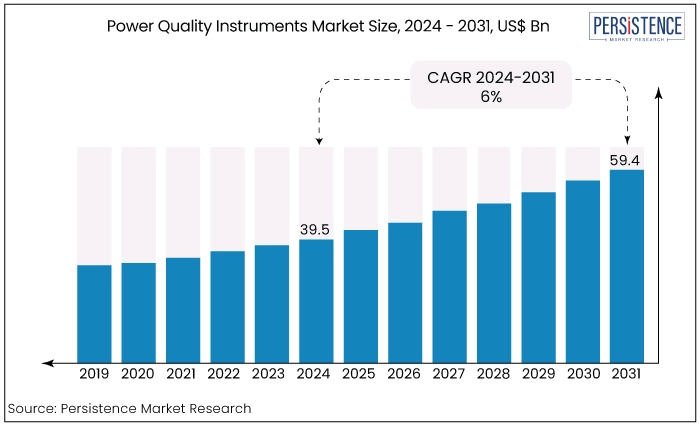Power Quality Instruments Market
Industry: Industrial Automation
Published Date: September-2024
Format: PPT*, PDF, EXCEL
Delivery Timelines: Contact Sales
Number of Pages: 188
Report ID: PMRREP34768
The power quality instruments market is estimated to increase from US$39.5 Bn in 2024 to US$59.4 Bn by 2031 exhibiting a CAGR of 6% during the forecast period from 2024 to 2031. The significant market growth is primarily attributed to the increased automation and digital technologies that are employed in industries and commercial sectors. The leading countries in North America such as the United States and Canada play vital role in the evolution of market.

Key Highlights of the Market
|
Market Attributes |
Key Insights |
|
Power Quality Instruments Market Size (2024E) |
US$39.5 Bn |
|
Projected Market Value (2031F) |
US$59.4 Bn |
|
Global Market Growth Rate (CAGR 2024 to 2031) |
6% |
|
Historical Market Growth Rate (CAGR 2019 to 2023) |
5.5% |
|
Region |
Market Share in 2024 |
|
North America |
33% |
North America's dominance in the market is driven by its advanced industrial infrastructure, stringent regulatory standards, and high adoption of cutting-edge technologies. The region's industrial sectors particularly in the United States and Canada reply on consistent power quality to maintain operational efficiency and prevent costly downtime. The region is projected to account for 33% market share in 2024.
The presence of leading industries such as manufacturing, healthcare, and IT where power reliability is critical fuels demand for sophisticated power quality instruments. North America's commitment to energy efficiency and sustainability drives the adoption of renewable energy sources like wind and solar which necessitate advanced power quality management.

The region's regulatory environment, with agencies like the Federal Energy Regulatory Commission (FERC) enforcing strict power quality standards further boosts the market. Ongoing investments in smart grid technologies and infrastructure modernization solidify North America's leading position in the global power quality instruments market.
|
Category |
Market Share in 2024 |
|
Product Type - Power Quality Analyzers |
40% |
Based on product type, the power quality instruments market is divided into power quality meters, power quality analyzers, and voltage testers. Among these, the power quality analyzers dominate the market and to account for 40% market share in 2024.
Power quality analyzers offer comprehensive analysis and diagnostics of power disturbances making them essential for industries with complex electrical systems. These analyzers are favored due to their ability to provide detailed insights into voltage fluctuations, harmonics, and other power quality issues enabling precise identification and resolution of problems.
Versatility and advanced features of analyzers make them crucial in sectors like manufacturing, utilities, and data centers. Maintaining optimal power quality is critical for preventing downtime and protecting sensitive equipment.
Power quality instruments are devices used to monitor, analyze, and manage the quality of electrical power. They detect and diagnose power disturbances such as voltage sags, swells, harmonics, and frequency variations that can disrupt operations or damage equipment.
The power quality instruments help ensure stable and efficient power delivery, maintaining optimal performance in electrical systems across industrial, commercial, and residential settings. The market for power quality instruments is witnessing significant growth fueled by the rising need for reliable and uninterrupted power supply across various industries and sectors.
Power quality instruments are critical tools used to monitor, analyze, and address power disturbances such as voltage sags, harmonics, frequency variations, and transient interruption. These can negatively impact equipment performance and operational efficiency.
These instruments are vital in identifying and mitigating power quality issues, ensuring optimal energy consumption and equipment longevity. As industries increasingly rely on sophisticated electrical systems particularly in manufacturing, utilities, healthcare, and data centers, the demand for effective power quality monitoring solutions continues to rise.
Integrating renewable energy sources, such as solar and wind, further underscores the importance of power quality instruments to maintain grid stability and prevent power disruptions. With the growth of smart grids and advanced energy management systems, these instruments are becoming indispensable in managing power quality in both developed and emerging markets.
The power quality instruments market experienced steady growth from 2019 to 2023, driven by increasing industrialization, the rising adoption of renewable energy, and the growing need for reliable power supply systems.
The market expanded as industries like manufacturing, healthcare, and utilities sought solutions to mitigate power disturbances that could damage sensitive equipment or cause operational downtime.
With the rising integration of renewable energy sources such as wind and solar into power grids, there was an increased need for power quality instruments to ensure grid stability and manage fluctuating power inputs.
The market experienced moderate growth rate largely due to economic slowdowns caused by the COVID-19 pandemic. However, with the gradual recovery of global industries post-pandemic, the demand for power quality instruments surged, particularly in regions like North America, Europe, and Asia-Pacific.
The market is expected to grow at a substantial compound annual growth rate (CAGR) over the forecast period, with continued investments in energy efficiency and grid modernization.
Emerging economies, particularly in Asia Pacific and Latin America are expected to play a key role in this expansion due to increasing urbanization and the ongoing development of energy infrastructure. The rise of digitalization and smart energy solutions will further propel market growth during the forecast period.
Increasing Industrialization and Urbanization
The rapid industrialization and urbanization globally is a key driver for the power quality instruments market growth. As industries expand, the demand for reliable and uninterrupted power supply becomes important especially in sectors like manufacturing, healthcare, and telecommunications. Even minor power disruptions can result in significant operational losses or damage to sensitive equipment in these sectors.
Urbanization, particularly in emerging economies is driving the need for stable electrical infrastructure to support the growing residential, commercial, and industrial sectors. Power quality instruments play a vital role in monitoring and managing power quality, ensuring that voltage levels, harmonics, and other power disturbances are controlled. Consequently, reducing equipment failure and improving energy efficiency.
Integration of Renewable Energy Sources
The global shift toward renewable energy sources such as wind and solar energy has significantly impacted the power quality instruments market. Renewable energy generation, while sustainable often leads to fluctuations in power quality due to the intermittent nature of sources like wind and solar power.
Power quality instruments are essential in maintaining grid stability and ensuring a smooth renewable power transition into the existing electrical grids. With governments and organizations increasingly investing in renewable energy projects to meet carbon reduction goals, the need for these instruments has grown. These further ensure reliable power distribution and mitigating disturbances that could arise from renewable integration.
Growth of Smart Grids and Advanced Energy Management
The ongoing development of smart grids and advanced energy management systems is another prominent growth driver for the power quality instruments market. Smart grids use digital technology to monitor and manage energy usage more efficiently reducing waste and improving the reliability of power systems.
Power quality instruments are integral to these smart systems enabling real-time monitoring of power disturbances and providing the data needed to optimize energy distribution. The shift toward smart grids are being propelled by governments and utilities globally as they seek to modernize aging electrical infrastructure, and enhance energy efficiency.
Demand for power quality instruments is expected to increase as these smart grids continue to be deployed supporting the transition to intelligent and sustainable energy networks.
High Initial Costs and Maintenance Expenses
One of the significant growth restraints for the power quality instruments market is the high initial investment required for purchasing and implementing these devices. Advanced power quality monitoring systems especially those used in industrial and commercial settings can be costly due to their complex technology and specialized functionalities.
In addition to the initial purchase cost, regular maintenance and calibration of these instruments are necessary to ensure accuracy and performance. For small and medium-sized enterprises (SMEs), these costs may be prohibitive limiting the widespread adoption of power quality instruments, which can slow market growth.
Lack of Awareness and Expertise
Another key restraint is the limited awareness and technical expertise regarding power quality issues and the need for monitoring solutions especially in developing regions. Several businesses particularly small enterprises may need to fully understand the impact of poor power quality on their operations and equipment. They may fail to invest in power-quality instruments without sufficient knowledge considering their unnecessary expenses.
The operation of power quality instruments requires technical expertise for accurate monitoring and analysis. In areas requiring more skilled personnel, this becomes a barrier to adoption limiting the market's growth potential. Increased awareness and training initiatives could help overcome this restraint but it remains a challenge in the current market landscape.
Expansion of Smart Cities and IoT Integration
One significant opportunity for the market lies in the rapid development of smart cities and the increasing integration of the Internet of Things (IoT) into power management systems. As cities globally adopt smart technologies to improve infrastructure, energy efficiency, and quality of life, power management becomes a critical focus.
Power quality instruments are essential in monitoring and managing the electrical environment of smart cities, ensuring that power is delivered efficiently and without interruptions. By providing real-time data on power quality, these instruments enable predictive maintenance, prevent downtime, and optimize energy use across city-wide networks. This opportunity is further enhanced by the rise of IoT, which enables power quality instruments to be more intelligent.
IoT allows for seamless communication between power quality monitors and other devices, providing real-time remote monitoring, diagnostics, and data analysis. This interconnected approach helps utilities and city planners manage power more effectively, reduce energy losses, and anticipate power quality issues before they occur.
As governments worldwide invest significantly in smart city projects particularly in regions such as North America, Europe, and Asia-Pacific, the demand for advanced power quality monitoring solutions will continue to rise. This creates a substantial growth opportunity for the power quality instruments market as these technologies are essential for ensuring the reliability and efficiency of the power infrastructure that smart cities depend upon.
The market is highly competitive with several key players striving to strengthen their market positions through innovation, product development, and strategic partnerships.
Leading companies such as Schneider Electric, Eaton Corporation, Siemens AG, and ABB dominate the market, offering comprehensive power quality solutions. These firms leverage their extensive industry experience and global presence to cater to various industries, including manufacturing, utilities, and data centers.
Emerging players focus on specialized solutions, including IoT-enabled power quality instruments, to gain a competitive edge. Strategic collaborations, mergers, and acquisitions are common as companies seek to expand their portfolios and geographic reach. Technological advancements and the shift towards smart grids further intensify competition in the market.
Recent Industry Developments in the Power Quality Instruments Market
|
Attributes |
Details |
|
Forecast Period |
2024 to 2031 |
|
Historical Data Available for |
2019 to 2023 |
|
Market Analysis |
US$ Billion for Value |
|
Key Regions Covered |
|
|
Key Market Segments Covered |
|
|
Key Companies Profiled in the Report |
|
|
Report Coverage |
|
|
Customization & Pricing |
Available upon request |
By Product Type
By Application
By Region
To know more about delivery timeline for this report Contact Sales

The market is estimated to increase from US$39.5 Bn in 2024 to US$59.4 Bn by 2031.
The integration of renewable energy sources drives the market forward.
Instruments that monitor, analyze, and manage electrical power to detect disturbances.
A few of the leading players in the market are Schneider Electric SE, Eaton Corporation, Siemens AG, and ABB Ltd.
Power quality analyzers to lead the market accounting for significant market share.